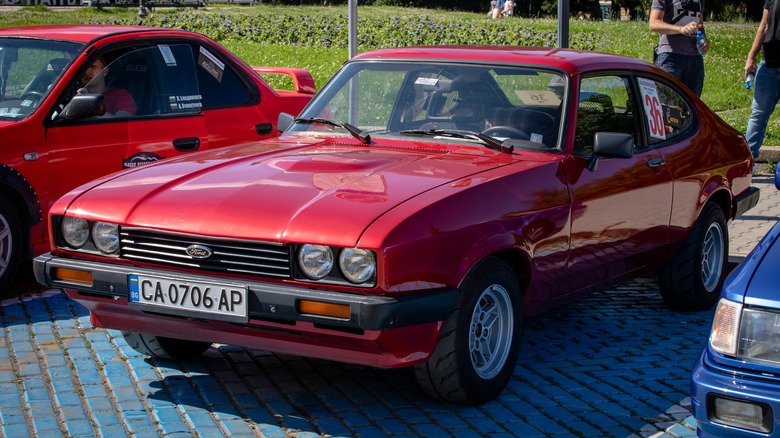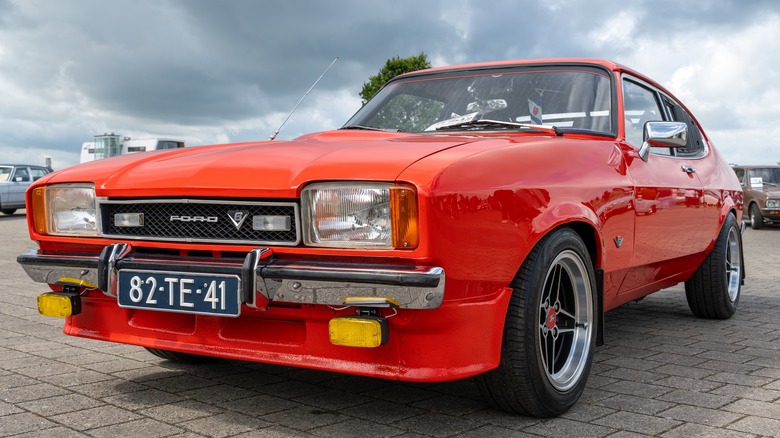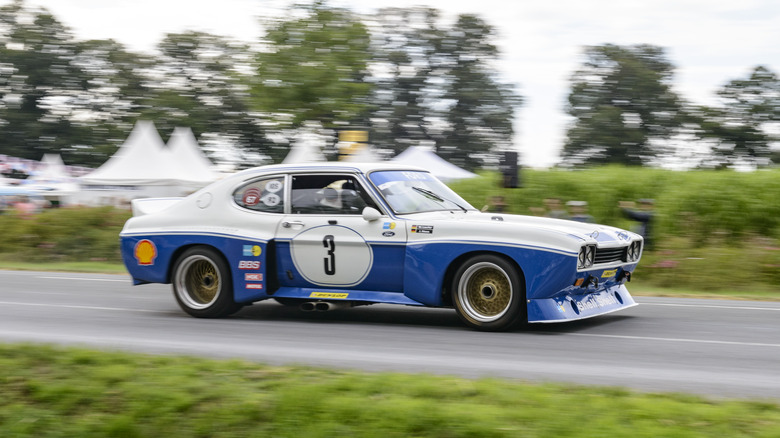What Was The Ford Capri And Why Was It Legendary?
In 1969, Ford was riding high. Five years prior, Ford launched the Mustang, which sparked a craze in the United States car market for affordable, powerful, sport-oriented cars which would later be called "pony cars." Between 1964 and 1969, Ford sold over 2.3 million Mustangs, quickly becoming one of the most recognizable and desirable cars of the 1960s — in America, that is.
Unfortunately for the rest of the world, Ford didn't offer the Mustang outside of the United States originally, leaving a pony-sized gap in other lucrative markets, including Europe. With the massive success of the Mustang stateside, Ford felt that there was no way that the same formula wouldn't work in European countries as well. At the time, Ford's European wing only had one car on offer specifically designed for the continent: the Escort. Despite later developing a reputation for being an incredible rally machine, the Escort arrived from the factory as an affordable and practical family car — a far cry from the mini-muscle car that the Mustang was. So, Ford Europe set its sights on building a European pony car.
The Ford Capri was first unveiled at the Brussels Motor Show in 1969, and became a massive sales success almost immediately. Within the first two years of production, Ford sold 500,000 Capris, proving that the pony car formula was just as lucrative in Europe as it was in the United States. The success continued for another 17 years and two additional generations, with the Capri selling two million units between 1969 and 1986. At that time, the Capri was celebrated for its versatility, value for money, sporty character, and good looks. The Capri also had a successful career in European touring car racing, bolstering its image in the eyes of enthusiasts as a true classic.
The Capri remained relevant through all three generations
Between 1969 and 1986, the Ford Capri was restyled three times, and managed to capture the intrigue of the automotive market each time. The initial Mk1 Capri was based on the nimble, small-wheelbase Mk2 Ford Cortina, and featured many of the same suspension and drivetrain components with other models to keep its base price at a very affordable £890 at the time. One of the best aspects of the Mk1 Capri was the sheer variety of options that it could be ordered in, with two trim packages and 11 different engine options; ranging from cheap four-cylinder models to the homologated RS3100, a road-going version of the Group 2 race car. The Mk1 Capri's range made it a car that anyone could afford in the right configuration, providing a sporty flair to everyday driving for the masses.
The Mk2 Capri was introduced during a tough period for sporty cars, as the 1973 oil crisis made thirsty engines impractical and costly. In 1974, Ford adapted the Capri to meet market demands, focusing on practicality and drivability over everything else. The Mk2 featured a more versatile hatchback design, softened suspension, and improved brakes, which kept the Capri alive during a time when many other sporty models floundered.
The final generation of the Capri arrived in 1978, and had a production run of 10 years. Interestingly, the Mk3 Capri wasn't new underneath its skin — it was just a heavy redesign of the Mk2. It didn't matter that the substance under the Mk3 was the same as years prior, as its sporty restyled body lines and performance-forward attitude were enough to make the Mk3 a smash hit with buyers. It also didn't hurt that the Mk3 was consistently winning races in multiple European touring car series.
The Ford Capri was a legendary race car
Outside of the Capri being a massive sales success on European streets, it was also a legend on racetracks around the continent. At the time of the Capri's release in 1969, Ford's Motorsport department was less than a year old and was eager to start racking up some victories. They wouldn't have to wait long, as an all-wheel-drive-converted Capri immediately won an English rally race that same year — a big accomplishment in the rally-obsessed U.K. At the same time as the rally effort, Ford was working on the RS2600 and RS3100 versions of the Capri for circuit and touring car racing, which would wind up winning both the European Touring Car Championship and German Circuit Championship in 1971.
1972 was an even more impressive year for the Capri, with the RS Capri taking overall victories in the German Automobile Racing Championship and the European Touring Car Championship for a second year in a row. In addition to the touring car championship wins, the Capri dominated multiple endurance races including a first and second-place finish in class at the 24 Hours of Le Mans, and a one-two-three finish at the 24 Hours of Spa Francorchamps.
Following its success in the early 1970s, the Capri wouldn't make a serious return to top-echelon racing until 1978, when the Group 5 Ford Capri Turbo continued to take wins in the German Racing Championship through 1980 and won the overall championship in 1981. The Capri's continual success in motorsport unquestionably helped sales in the consumer market, cementing the model as a legend both on and off the track.


